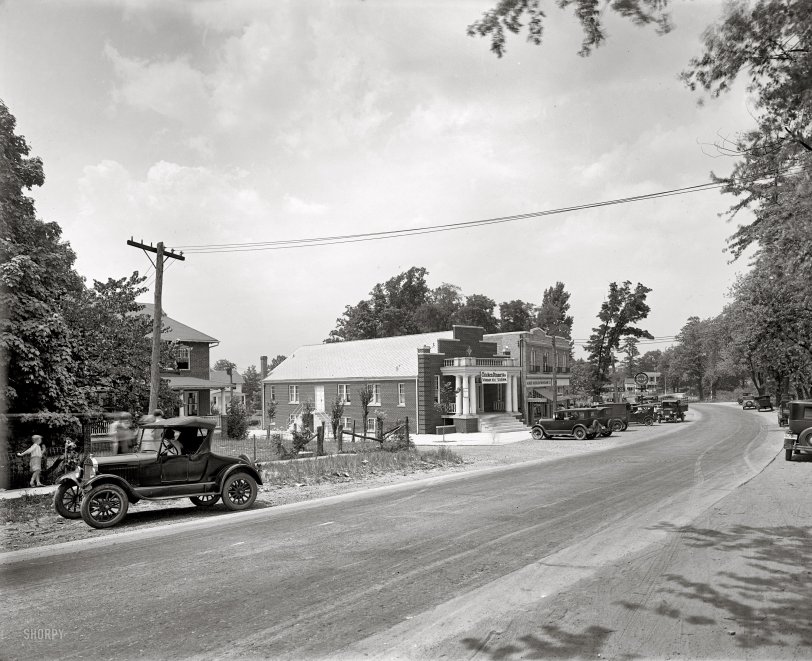


Framed or unframed, desk size to sofa size, printed by us in Arizona and Alabama since 2007. Explore now.
Shorpy is funded by you. Patreon contributors get an ad-free experience.
Learn more.

- What a headache!
- Baldwin 62303
- Baldwin VO-1000
- Cold
- No expense spared
- Tough Guys
- Lost in Toyland
- And without gloves
- If I were a blindfolded time traveler
- Smoke Consumer Also Cooks
- Oh that stove!
- Possibly still there?
- What?!?
- $100 Reward
- Freeze Frame
- Texas Flyer wanted
- Just a Year Too Soon
- WWII -- Replacing men with women at the railroad crossing.
- Yes, Icing
- You kids drive me nuts!
- NOT An Easy Job
- I wonder
- Just add window boxes
- Icing Platform?
- Indiana Harbor Belt abides
- Freezing haze
- Corrections (for those who care)
- C&NW at Nelson
- Fallen Flags
- A dangerous job made worse
Print Emporium
Chicken Dinner Here: 1927

Silver Spring, Maryland, circa 1927. One of three National Photo glass negatives with the caption "Jordan & Co." National Photo Company. View full size.
Sunny's Surplus
I think the K of C building also housed Sunny's Surplus in the 60's. There was a great old green-painted brick building across Georgia Avenue that housed a slot-car facility around the same time.
Emulsion Speed in the '20s
In the 1920s, photographic media weren't rated at standard speeds the way we do today. But if they were, their ISO numbers would generally fall in the 8 to 16 range, with a few "Super Speed" and "Ultra Speed" emulsions being as fast as ISO 32. The proper exposure in full sun, like this picture, with an ISO 16 emulsion, would require around 1/15 second at f/16. A large format camera, like those that used glass plates, would require at least f/16, if not a smaller aperture, to yield the depth of field seen here.
I pulled out my copy of "The Camera, the Photographic Journal of America" from June 1926 and reviewed the exposure info for some images and found that most exposures made on sunny days were longer than 1/15.
Shutter speed.
Glass plates and film had similar speeds. The use of a slow shutter speed was due to the need to stop the lens down for depth-of-field, in other words a large area from foreground to background that the photographer wanted to keep sharp. I shoot the same size film now, and I often use shutter speeds in the 1/4 to 1 second range in order to stop the lens down for maximum sharpness front to back in the scene being photographed.
Windows and trees
This is just a wonderful photograph, catching a casual moment long gone. I live in a house built in the mid-1920s, and its wood-framed windows are exactly the same as those along the side of the Knights of Columbus Hall. There is a touch of modernity, yet not-so-modern in this photograph. With the black and white detail, you can almost hear the dry breezes rustling through the branches of the trees. A muted moment that is spectacular.
K of C
The building hosting the chicken dinner was the Knights of Columbus Hall, 8500 Georgia Ave. Built circa 1926, it was sold in December 1930 and remodeled for use as a house of worship by the newly founded St. Michael's Parish. The congregation moved in 1952 to its present home at 805 Wayne avenue.
Jelly Roll Morton and more
Jazz pianist and composer Jelly Roll Morton used to talk about filling up his Cadillac with "that good Gulf gas," and I thought it a phrase he had made up -- now I know he was someone else who had fallen under the spell of a catchy slogan. For me, the most evocative part of this delicious scene has to be the shadows of unseen trees, bottom right.
Love Silver Spring
It lasted until at least 1970 and by 1980 it was mostly gone.
historicalaerials.com shows how it used to hardly be an intersection at all!
Film Speed
A day-time photo in the 20's still with a slow shutter speed? I would have thought by this point that the film would have been fast enough to stop the action. Just what film speed were they using in those days?
[They weren't using film. As noted in the caption, this scene was recorded on glass. - Dave]
Nothing Left
According to Jerry McCoy's "Historic Silver Spring" (which has this photo), this is the west side of Georgia Avenue at Harden Street (now Wayne Avenue). All modern office buildings now.
























On Shorpy:
Today’s Top 5